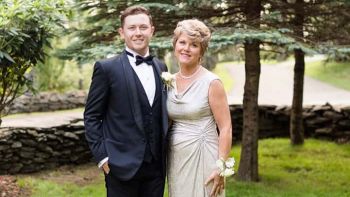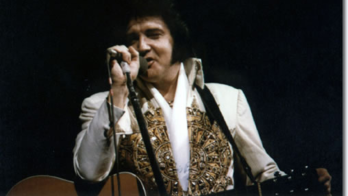On Butterflies and Little Girls Growing Up (A True Story)
by Dave O’Brien
When my daughter was very young she liked to be tucked into bed every night with a few butterfly kisses from Daddy. The O’Briens have unnaturally long eyelashes so it’s only appropriate that we use a flutter or two of them to say “I love you” to one another. Every night she would climb under the covers and, when she was ready for me to come into her room, announce “OK Daddy!” like the choreographer of our little routine.
She outgrew the nightly ritual by the time she was 5 or 6, I don’t remember exactly when, but it was around the same time she was outgrowing so many other things – holding Mommy or Daddy’s hand in public; using training wheels; playing only on the small slides at the playground. She may not now even remember the bedtime butterfly kisses anymore but her Daddy does.
My daughter has always loved butterflies…and any living thing for that matter – flowers and birds and her dog Benson and horses, especially horses! She has a horse, Sunflower, and has spent countless hours and days riding her, grooming her, showing her, talking to her, loving on her and giving her some of the hugs and kisses that Daddy used to get.
She also loves plants and even has a set of shelves in her bedroom full of all different sorts of potted and hanging plants – exotic pitcher plants, cacti, bamboo.
This past spring my daughter wanted to take over one-quarter of our backyard vegetable garden to plant native Indiana prairie plants, creating a butterfly and pollinator garden. I had no problem with the idea since the vegetable garden regularly produced only a handful of tomatoes, some freakishly small cucumbers and mild annual aggravation for me.
She did her research and selected just the right mix of plants; she ordered a bee house to attract mason and cutter bees and put a butterfly feeder right in the middle of all of it. She refilled the nectar in the butterfly feeder whenever my wife refilled the hummingbird nectar in the feeder by our kitchen window.
The garden grew quickly (I guess native plants like the native environment); some bees moved in (not as many as hoped but it is a new home in the middle of many other established alternatives) and the butterflies arrived, monarchs and viceroys, skippers and question marks.
Recently, the night before my daughter moved out of our house to start her first year at college, she found a butterfly cocoon, a chrysalis, attached to the wall of our screened-in back porch. She worried that the butterfly would emerge from the cocoon and, unable to get out of the porch, would not survive.

(Chrysalis on the porch)
She again did her research, this time on how to transplant a chrysalis to a new location. She posted a picture of it on an Indiana butterfly Facebook page (yes, there is one – actually more than one) asking what type of butterfly the chrysalis might yield. She immediately got several answers from people apparently flush with butterfly knowledge, just eager for someone to ask. It was some type of swallowtail, likely either a black swallowtail or black and gold giant swallowtail. (Did I mention she was getting ready to head to Purdue University? Home of the Black and Gold Boilermakers?)
We went on a scavenger hunt around the house looking for a spray bottle, a needle, a Tupperware container, paper towels, pushpins, sticks and some netting – all necessary for a successful chrysalis transplant. We had everything but the netting. My daughter found an old yellow costume tutu she had worn for a high school spirit day. Since her high school days were behind her and she no longer needed the tutu, she suggested we cut it up and use it to cover the Tupperware container that would eventually house the chrysalis.
The delicate operation of removing a chrysalis by using a needle to separate its silk from wherever it has anchored itself was more time consuming than you, or we, would imagine. My daughter kept apologizing for keeping me awake so late on the night before we were going to drive her the hour and 15 minutes to West Lafayette to check in to her new dorm by 9 a.m. Every time she said “I’m sorry” all I could think was that this type of adventure, this spirited project, was exactly what I was going to miss most about having her around the house.

(Chrysalis pinned to paper towels)
She finally successfully removed the chrysalis from the wall, transplanted it to some paper towels that were secured to sticks with pushpins in the Tupperware container. We secured the netting over the top and then looked at each other and said “now what?”

(The chrysalis habitat)
It was decided that my daughter would bring the chrysalis with her to her new dorm room in case the butterfly emerged while my wife and I were at work. We didn’t want the butterfly trapped for hours in the Tupperware container any more than we wanted it trapped on the screened-in porch.
The next morning, as we packed every last inch of our Chevy Tahoe with clothes and shoe racks and a dorm fridge and even a potted plant, we left a spot where my daughter could sit with the Tupperware chrysalis incubator on her lap.
Purdue does not allow pets in freshman dorm rooms with the exception of small aquarium fish but we figured that the chrysalis was not so much a pet as it was a project. And my daughter was getting ready to study plant science and botany, a field closely related to pollinators like the butterfly we hoped was still healthy after the chrysalis transplant.
Several upper classmen resident assistants were helping the freshman move into their dorms that morning and one of them asked my daughter “is that some sort of pet?” My daughter mumbled something and kept walking but later in the day told me she was worried she might get in trouble.
It was decided that the chrysalis, which had since been named Petaluda, the Greek word for “butterfly” (at least according to Google Translate), would return home with Mom and Dad (we had gone from Mommy and Daddy to Mom and Dad sometime in the years after the last of the butterfly kisses).
My wife and I knew it would be tough to go into our daughter’s nearly empty room for a while after dropping her off at college but, when we got back home, it was surprisingly easy to go in there and place Petaluda’s container on the shelves that once housed all of the plants. It was as if a small part of my daughter’s personality were still in the house.
Three days after returning from Purdue I made my daily, afternoon, post-work butterfly welfare check. The chrysalis, while still attached to the paper towel, stick and pushpin infirmary, had split open and was now empty. There, clinging to the underside of the costume tutu netting on top of the Tupperware container was Petaluda, the black swallowtail butterfly.

(Petaluda emerges)
She was flapping her wings, drying them off after her emergence from the cocoon. I gently picked up the container, grabbed my cell phone to document the moment (has there been an undocumented moment in any of our lives in the past decade?) and headed for the back door and the screened-in porch where this all began.
I left the porch, went into the backyard and over to my daughter’s butterfly and pollinator garden. I carefully removed the costume tutu netting, with Petaluda still clinging to it, and placed it on one of the native prairie plants. She immediately moved off of the netting on to the plant and continued to dry her wings, now flapping them in the light afternoon breeze.

(Petaluda on the plant)
I stood and watched her for a few moments before heading back to the house to finish changing out of my work clothes. About 20 minutes later I went back out to check on Petaluda to make sure this whole saga didn’t end with her being eaten by a crow or laying upside down in the dirt.
She was still sitting on the plant where I left her but, as I approached, while maybe ten to fifteen feet away from her, she took flight. She flew around the other garden plants briefly, rose up in the air, circled a bit of the backyard and flew over our fence toward a large grove of trees.
I lost sight of her pretty quickly and tried to follow where she had gone but was not able to see her again.
I turned to collect the Tupperware container and netting and checked my phone to look at the pictures and videos of Petaluda on the plant that I would soon be sending my daughter.
I was pleased with what I had managed to film. My daughter was super pleased with what I texted her. She posted the pictures on her Facebook page with the comment “thanks Dad for keeping an eye on her!” She got a dozen likes right away and some comments started to trickle in.
And, even though she wasn’t there and she doesn’t realize it, my daughter gave her Daddy one last butterfly kiss before spreading her wings and flying off into the world.
















